| 1 | The easiest snake to recognise |
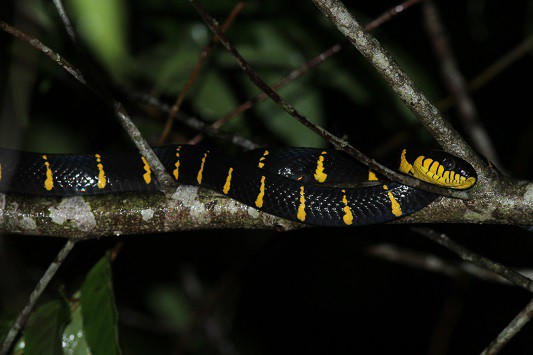
The mangrove catsnake is a species of southeast Asia, ranging from southern Thailand through Singapore to a swathe of Malaysia and Singapore. They’re part of the 42 member Boiga catsnake family, the same as the invasive brown tree snake on Guam. This species has the honour of being perhaps the simplest snake to recognise in all of its territory.
You don’t need to be a PHD or a trained herpetologist. Mangrove catsnakes have just two colours on their body – dense yellow and midnight black, with the exception of a purple mouth and tongue. This snake can be ID’d in two seconds, as there’s no snake within their range with such striking colours.
While there’s variety in patterns, black typically forms the underbase while yellow bands encircle the body. Vivid black-yellow snakes exist around the world – tiger ratsnakes, Usambara eyelash vipers. But none inhabit Singapore or Malaysia where mangrove catsnakes are common. Furthermore, there’s definitely no snake nearby that combines these colours with a brute size. Mangrove catsnakes average at 1.5-2.5 metres, with an alltime record of 2.8 metres. This is one of the longest non-pythons in Asia, and longest non-constrictors after the king cobra.
| 2 | Rests on branches for hours |
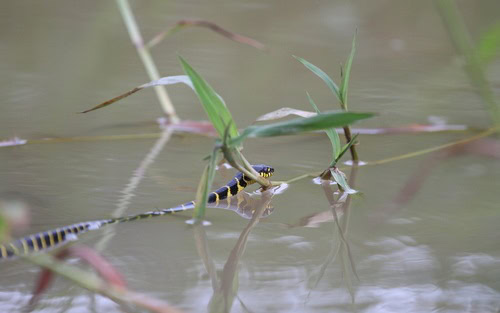
Mangrove catsnakes are nearly always spotted draped calmly over branches, 1-3 metres above ground. Forests are their realm, including their namesake mangrove forests, but also lowland rainforests. Mangrove catsnakes aren’t fussed about camouflage, instead resting openly on large branches where passing tourists can’t fail to notice their black-yellow colours.
They’re also excellent swimmers. One of their tendencies is to remain completely still, then instantly drop off a branch when people stray too close, landing in the body of water directly below with a splash. Consequently, mangrove catsnakes particularly favour branches directly over lakes or rivers.
Their temperament varies. Some stay calm and gaze into your eyes inquisitively as you approach, while others fly into an unbridled rage and stab at your face with vicious lunges. The consensus is that by day, they’re far calmer, before their aggression rises and boils over post sunset. The mangrove catsnake is much more dangerous in pale moonlight than bright sunlight. While their pupils are vertical like most nocturnal snakes, their eyes are such a dense black that this is impossible to make out.
| 3 | Best spotted above riverbanks |
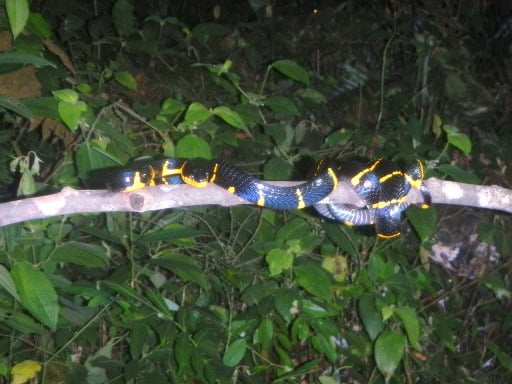
Mangrove catsnakes aren’t the hardest species to find. In Singapore, you can easily find them in the ring of nature reserves surrounding the forested centre, such as Chestnut Nature Park and Upper Seletar Nature Park. Perhaps the greatest hotspot of all is Khao Sok National Park in southern Thailand, judging by the amount of dots on this iNaturalist map. This lies approximately 2hrs 30 minutes from the coastal resort of Phuket. This species can be scarce in certain locations, but extremely common in others. If there’s anywhere you should go to find this snake, it’s Khao Sok.
Mangrove catsnakes apparently have a completely isolated population in Cambodia as well. They completely disappear in central Thailand, including near Bangkok, yet there’s a small pocket on the coastline of the Gulf of Thailand. In Indonesia, the easternmost point they reach is Sulawesi, as they have no presence on New Guinea nor Maluku. Consequently, they also get nowhere near Australia.
Wherever they live, mangrove catsnakes are commonly sighted on branches along rivershores as your small fishing boat sails past. They coexist with the mangrove pitviper, but that species is far stricter about only inhabiting mangroves, while mangrove catsnakes are slightly more flexible.
| 4 | Diet of the mangrove catsnake |
In 2003, scientists were tracking the large treeshrew (Tupaia tana) in Malaysia’s Danum Valley, a thick round mammal which regularly exceeds 30cm. The beeping accelerated as they approached the radio transmitter source, but when they arrived, they were looking at a mangrove catsnake, perched 5 metres high on a branch. When the black-yellow snake moved 100 metres the next day, so did the radio transmitter. The fate of the mammal was clear.
Mangrove catsnakes have one of the least fussy diets in the Boiga catsnake family. A study from the 1970s found 54 prey items in 52 snakes. The catsnake enjoyed a wondrous buffet, sampling all juicy delights the rainforest had to offer.
The result was 15 lizards, 7 snakes, 17 mammals, 13 birds, and finally one frog, showing that amphibians are the one class they tend to avoid. The study found a large shift in age, as juveniles ate mainly ectothermic prey such as lizards, occasionally snakes, while adults ate endothermic prey such as mammals and birds. One of the lizards unearthed was a crocodile monitor (Varanus salvadorii), the third longest surviving lizard on Earth, at up to 2.55 metres, although this prey found was probably a youngling. They’re also proven to eat clouded monitors, the second largest lizard (the Komodo dragon ranks first).
| 5 | Connections to fellow snakes |
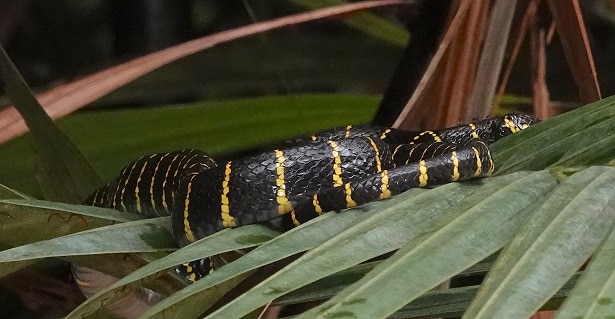
Within the serpent kingdom, mangrove catsnakes are near the summit of the food chain, but just a few steps short. On July 4th 1998, a king cobra measuring 1.5 metres was spotted swallowing a mangrove catsnake on Mandai Lake Road in Singapore, near Singapore Zoo.
Meanwhile, the study above found the following snakes in the mangrove catsnake’s own diet:
Golden flying snake (2 recordings) – a nimble, energetic tree snake with the power to glide by enlarging its vertebrae to capture air pockets. While capable of rapid escape, they also rest on the same branches where mangrove catsnakes wait in ambush.
Dog-toothed catsnake (1) – this fellow family member is actually the larger, being the second largest of the Boiga catsnake genus after brown tree snakes, with mangrove catsnakes coming third.
Common mock viper (1) – one of the closest viper mimics in the world. This harmless, widespread snake covers virtually the entirety of the mangrove catsnake’s range.
Malayan pitviper (1) – a feared snake by southeast Asian farm workers. This proves that mangrove pitvipers can swallow and digest dangerously venomous snakes.
In another encounter, a mangrove catsnake was spotted resting 1.5 metres high on a branch in Sarawak, East Malaysia (Borneo). It had a large abdominal bulge, and soon coughed up a painted bronzeback (harmless) measuring 80cm. The mangrove catsnake was estimated at 1 metre, barely longer than its prey.
| 6 | Not lethal, but neurotoxic |
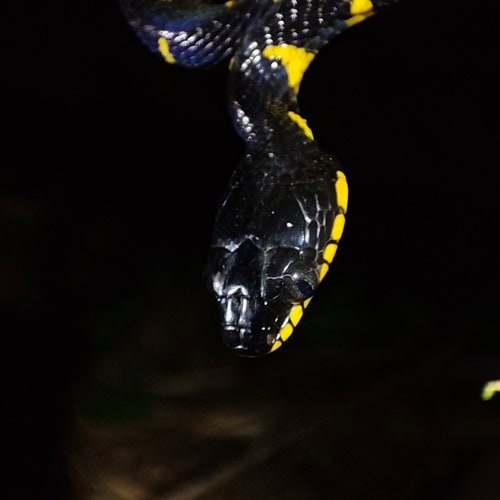
Mangrove catsnakes are moderately venomous, and have never killed a human (in recorded history anyway). But over the last 25 years, new secrets have been discovered within the complex toxin elixir that makes up their venom. It turns out that the Boiga genus is way more neurotoxic than once believed.
The Boiga catsnakes are colubrids, whereas the most neurotoxic snake clan is easily the Elapids, which includes sea snakes, cobras and coral snakes. In particular, only Elapids generally contain three-finger toxins, but starting in the late 1990s, Boiga became the first colubrid group confirmed to contain them. The first study simply discovered that toxins from the mangrove catsnake’s Duvernoy’s gland had a blocking effect on muscular acetylcholine (AChR) receptors. This is the hallmark of post-synaptic neurotoxins such as the black mamba’s.
Fast forward to 2005, and scientists isolated a specific neurotoxin from mangrove catsnake venom, dubbed boigatoxin-A. This was tested on a chick nerve-muscle preparation, and found to cause a “poorly reversible postsynaptic blockade“, with irreversible being the most powerful.
| 7 | 100 times deadlier in birds |
But a 2006 study by the same team changed everything. It identified and crystallised a new neurotoxin, denmotoxin, which was unique to mangrove catsnakes. Furthermore, this was highly specialised, being 100 times more potent against birds than mice. Again, this was a classic post-synaptic neurotoxin, but in birds, the blockage of AChR receptors was “irreversible“, compared to a “much weaker, readily reversible blockage” seen in mice.
The latest development happened in 2019, and involved the infamous brown tree snake (Boiga irregularis). This Australian native has invaded the US-occupied island of Guam and driven 10 of 12 native forest birds to extinction. Boiga irregularis produces its own neurotoxin which is heavily targeted against avian prey – irditoxin.
Originally, scientists assumed that this was unique to the species, explaining its unusually destructive ability. But in 2018, scientists examined 5 members of the Boiga catsnake family, and found irditoxin in every one. This included mangrove catsnakes, as well as dog-toothed, black-headed and common catsnakes. Irditoxin wasn’t so unique after all. It’s believed that if another catsnake had happened to be the first to invade Guam, perhaps even the mangrove catsnake, that species would have been equally devastating.
| 8 | 3 confirmed neurotoxins |
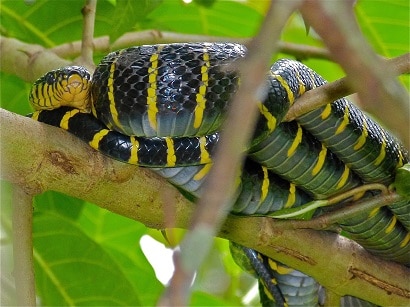
There are now three confirmed neurotoxins in the mangrove catsnake: irditoxin, boigatoxin-A, and denmotoxin. But what about humans, considering that mice were barely affected? The most detailed mangrove catsnake bite report dates back to 1991. A reptile enthusiast owned three mangrove catsnakes – an aggressive but smaller male, a smaller non-aggressive female, and a larger (2.2m) aggressive female.
The owner was handling the large female when he was bitten on the left wrist. Each fang mark was a v-shape, 1cm on each side, and the fang marks were 5cm apart. The first symptom arrived the next day (August 13th), with fatigue and aching joints. This was followed by fatigue and listlessness on August 14th, plus a wave of nausea, intense aching and joint pain, and stabbing pain in the kidneys. One report was similar to an early black mamba symptom: a metallic taste in the mouth.
By August 15th, 3 days later, the symptoms were subsiding, and on August 16th, the man had completely healed. The report mentioned almost no local symptoms, again similarly to a black mamba, making it line with a heavily neurotoxic snake, but one which is relatively muted in mammals, as the man suffered no seriously threatening effects. The green vine snake is another species which wields rare neurotoxins, but which are weak against mammals (in this case targeting lizards and birds).
| 9 | Split into two species (2020) |
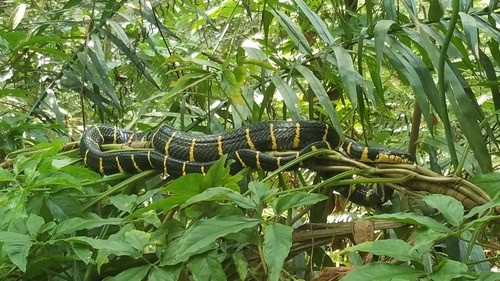
The typical mangrove catsnake has a black upper half of the head always beginning below its eyes. The lower half is yellow, streaked with extremely thin vertical black markings. The black portions can have an iridescent sheen as well.
In 2020, the mangrove catsnake was split into two independent species. Boiga dendrophila was dubbed the gold-ringed catsnake, and occupies most of Indonesia, the Philippines and eastern Malaysia. The western form remained the mangrove catsnake (Boiga melanota) and occupies peninsular Malaysia, southern Thailand and Singapore. Subtle differences were discovered, such as gold rings which fail to meet at the spine in the western form, always remaining slightly disjointed. The western version also lacked yellow markings on the belly. In the Singapore/Thai form, you’re more likely to find individuals with severely reduced yellow, with black almost dominating (see this photo).
Even though there’s patterns by region, you can still find unusual morphs within each region. Witness these examples from Indonesia’s Riau Islands, taken from a small boat sailing through a tidal mangrove inlet. They contain some of the least yellow of any mangrove catsnake yet discovered, reduced to mere blotches of yellow paint or wonky circles. These were Boiga melanota, but even then, the yellow was reduced to way below the norm.
| 10 | Subspecies guide |
The uber common green catsnake (Boiga cyanea) has only 1 subspecies, but the eastern mangrove catsnake has 8 different subspecies, probably because it’s split between so many island nations, allowing huge genetic chasms to open up. For example, the Philippines contains three subspecies across its various islands:
Boiga dendrophilia latifasciata – found on the islands of Mindanao and Samar. Contains the fewest encircling yellow bands, with 60 in total, with 16 on the tail. Contains the fewest ventral (belly) scales as well, ranging from 207 to 222. Has the most memorable appearance, as each yellow scale is tipped with black, giving the yellow bands a messier look.
B. dendrophilia multicincta – found only on Palawan. Possesses 90-110 yellow bands, and the most ventral scales at 220-240.
B. dendrophilia divergens – found on Luzon and Samar. This is the least vividly black-yellow subspecies, with numerous grey scales creeping in. This subspecies is intermediate in the number of bands (81-97) and ventral scales (219-228).
A 2020 study stated that B. d. divergens will probably be made an independent subspecies one day, as will three others: B. d. levitoni, B. d. occidentalis, and B. d. annectens.